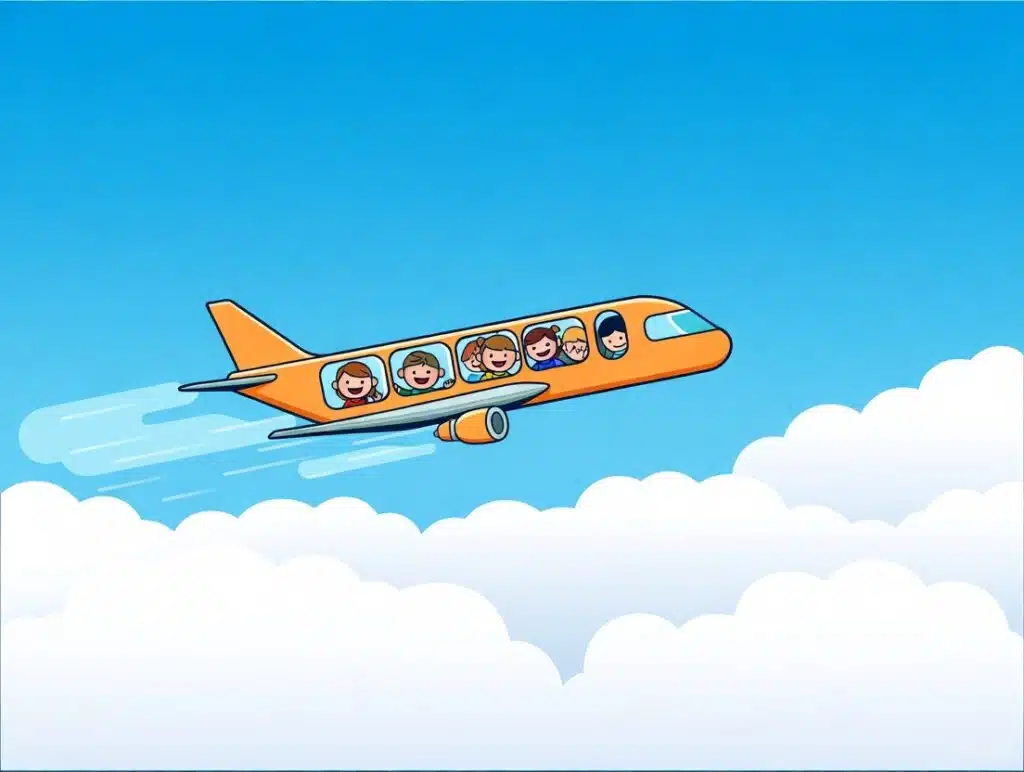The Flying Wonder
Have you ever looked up at the sky and seen a giant airplane soaring high above the clouds? It looks almost magical. How can something so heavy, carrying hundreds of people, stay in the air without tumbling down?
Airplanes are one of humanity’s greatest inventions, but they don’t fly by magic. They fly because of science — the science of lift, thrust, drag, and weight. These four forces work together like teammates to keep an airplane balanced in the sky.
Let’s take a fun journey into the science of flight and discover how airplanes manage to float across the skies safely.
Why Doesn’t an Airplane Fall?
An airplane is made of metal, engines, fuel, and many heavy parts. So, why doesn’t it simply drop like a stone?
The secret lies in the airplane’s wings and how they are shaped. The wings are specially designed to interact with air in a way that creates lift — an upward force that beats gravity. This lift is the superhero power that keeps airplanes flying.
The Four Forces of Flight
To understand airplanes, we need to know about the four important forces:
- Lift – The upward push created by the wings.
- Weight – The downward pull of gravity.
- Thrust – The forward force created by engines or propellers.
- Drag – The backward pull of air resisting the airplane’s movement.
For a plane to fly:
- Lift must be greater than weight.
- Thrust must be greater than drag.
When this balance is achieved, the airplane stays smoothly in the sky.
How Do Wings Create Lift?
Airplane wings are not flat. They are curved on the top and flatter on the bottom. This special design is called an airfoil.
When the airplane moves forward:
- Air on top of the wing moves faster.
- Air below the wing moves slower.
According to a rule called Bernoulli’s principle, faster air pressure is lower, and slower air pressure is higher. The higher pressure under the wing pushes upward, creating lift.
That’s why wings are the real heroes of flying.

Engines: The Power of Thrust
Lift alone is not enough — the airplane needs to move forward to create airflow over the wings. That’s where engines come in.
- In big airplanes, jet engines push air backward at high speed, creating forward thrust.
- In smaller planes, propellers spin and pull the airplane forward.
Engines are like the muscles of the plane, giving it the power to cut through the sky.
Gravity and Drag: The Challengers
While lift and thrust help the airplane, gravity and drag try to pull it down or slow it.
- Gravity always pulls everything down toward Earth. Planes overcome this by creating strong lift.
- Drag is air resistance. Just like when you run against the wind, airplanes feel a push backward. Engineers design planes to be smooth and aerodynamic to reduce drag.
The airplane’s flight is a constant battle of these four forces. When they balance correctly, the plane glides like a bird.
Flying Like Birds
Humans actually learned about flying by watching birds. Birds stretch their wings, tilt them, and flap to create lift and thrust.
Airplanes don’t flap, but pilots can tilt the wings and tail to control direction. The tail helps balance the plane, while flaps and ailerons on the wings guide its movement.
So, in a way, every airplane is a giant metal bird.
How Do Pilots Keep Planes Steady?
Flying a plane is not just about engines and wings — it also needs skilled pilots. Pilots use special controls to keep the airplane safe and balanced:
- Elevators control up and down movement.
- Ailerons control tilting left or right.
- Rudders control turning left or right.
Pilots work with these controls, along with powerful computers, to keep flights smooth.
Amazing Airplane Facts
Here are some exciting airplane facts that make flying even cooler:
- A jumbo jet can weigh over 400,000 kilograms — yet it still flies!
- The fastest passenger jet ever, the Concorde, could travel faster than the speed of sound.
- Some airplanes can fly for more than 18 hours non-stop.
- Airplanes fly at around 35,000 feet, high above the clouds, where the air is thinner.

Why Don’t Airplanes Just Drop from the Sky?
Airplanes don’t fall because:
- Lift keeps them up.
- Engines keep them moving.
- Pilots and computers constantly adjust controls.
Even if one engine fails, airplanes are designed to glide safely and land. This is why flying is considered one of the safest ways to travel.
The Future of Flying
Airplanes are getting smarter and greener. Engineers are now designing:
- Electric airplanes that run on batteries.
- Solar-powered planes that use sunlight.
- Faster, quieter, and more fuel-efficient designs.
The dream is to make flying safe for the environment while still connecting people around the world.
Conclusion: Flying Is Science in Action
Airplanes stay in the sky because of the teamwork of four forces — lift, weight, thrust, and drag. Their wings create lift, engines provide thrust, and smart designs reduce drag, all while pilots and computers keep everything balanced.
So, the next time you look up at an airplane, remember: it’s not magic — it’s amazing science in action.

